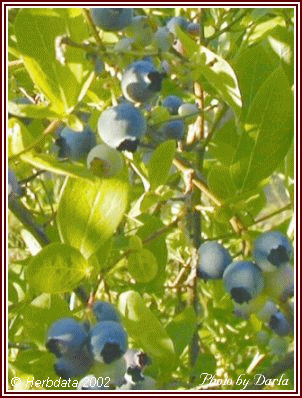
 Bilberry - Potters Cyclopedia 1988
Bilberry - Potters Cyclopedia 1988
Compiled by Ivor Hughes
BILBERRY Vaccinium myrtillus L.
Fam. Vacciniaceae
Synonyms: Huckleberry, Whortleberry, Hurtleberry, Blueberry. Habitat: Grows chiefly in moorland, heaths and on acid soil in the UK,
Europe and N. America and cultivated extensively. It flowers in May, the
berries ripen in July. Description: Fruits blue-black, globular, about 0.5-1 cm in diameter with
the calyx ring at the apex and containing numerous small oval seeds.
Part Used: Ripe fruit. Constituents: (i) Anthocyanosides, at least 0.3% [137] (ii) Vitamin C (iii)
Plant acids such as citric and malic. Unlike other Vaccinium species,
bilberry does not contain arbutin, or other hydroquinone derivatives
Medicinal Use: Astringent, diuretic, refrigerant; used particularly for
diarrhoea, as a decoction. The anthocyanosides inhibited barium induced contractions in isolated thoracic vein [139] and coronary artery smooth muscle [140] in vitro. These effects are thought to be mediated by stimulation of vasodilatory prostaglandin production [140]. See also Blackcurrant. Bilberries are used mainly as a food. Preparations: Liquid Extract, dose: 2-8 ml.
![]()